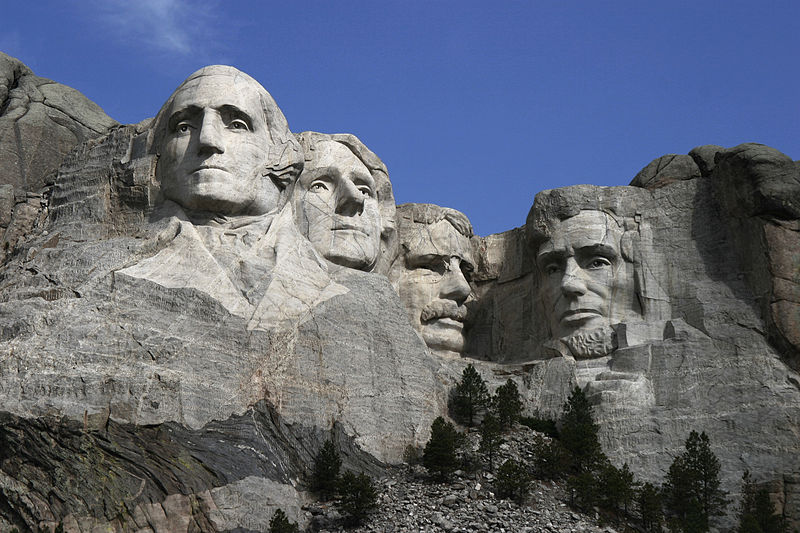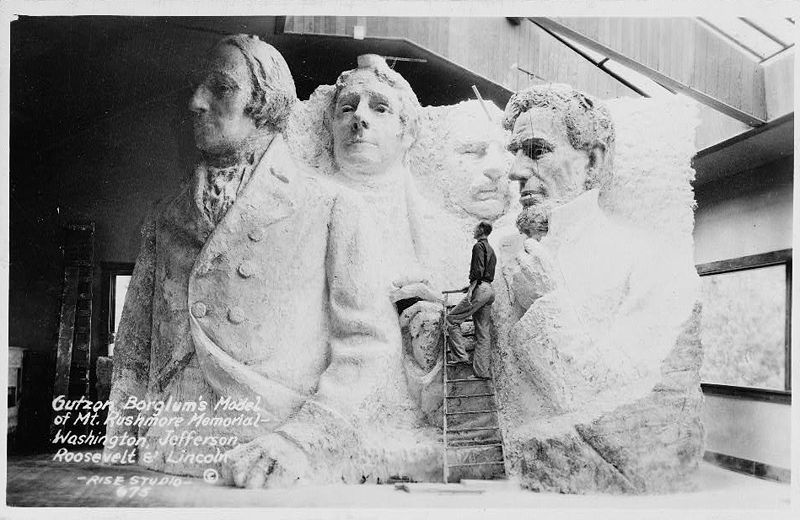Behind the Presidents

Mount Rushmore, above, is one of the United States’ most recognizable national landmarks. The cliff-size carving of four presidents — George Washington, Thomas Jefferson, Theodore Roosevelt, and Abraham Lincoln — was designed to bring tourism to the Black Hills region of South Dakota. The memorial was established in 1925, carving began in 1927, and construction completed in 1941.
It is also a time capsule of sorts.
The original design for Mount Rushmore featured more than just the heads of the presidents depicted, but unfortunately, the project ran low on funding. It was deemed complete prematurely, and for most tourists, there’s no reason to suspect otherwise. But the original designer and sculptor, Gutzon Borglum, had a much grander dream. For example, as seen in the model pictured below, the presidents were supposed to have upper bodies.

But there was more. As Smithsonian magazine notes, “Borglum’s 1935 conception for the monument called for a grand public stairway leading from the base of the mountain to a hall of records, behind the presidential heads.” Again, budgets decided otherwise — but in this case, the deviation from the plan was only temporary. For decades after Borglum’s death (he died a few months before the monument was deemed complete), his family pressured the National Park System (NPS) to finish that part of the original concept. In 1998, the NPS agreed. Situated behind the monument, chiseled out of the rock, is the Hall of Records.
The Hall of Records, though, isn’t a tourist attraction, and there is no “grand public stairway.” It’s not open to the public at all. In 2007, a writer for National Parks Traveler gained access (with permission) to the Hall, and described it as a chamber, created with no expectation of anyone entering any time soon. The Hall contains, per that article, “sixteen porcelain enamel panels containing the text from the Declaration of Independence, the Constitution, and the Bill of Rights, along with a biography of Borglum, and the story of the presidents.” This collection of historical engravings “were sealed in a teakwood box, then placed in a titanium vault, and finally sealed shut under the weight of a 1,200 pound granite capstone inside the unfinished hall.”
The goal of the Hall is for future civilizations to find and, ultimately, learn about the civilizations of its day. This is made clear by the inscription on the Hall’s capstone: “Let us place there, carved high, as close to heaven as we can, the words of our leaders, their faces, to show posterity what manner of men they were. Then breathe a prayer that these records will endure until wind and rain alone shall wear them away.” Those words, originally by Borglum, summarize why he embarked on the project in the first place, and likely why his family pushed for the creation of the Hall, half a century after the monument was otherwise completed.
Bonus Fact: If future civilizations do end up relying on what’s in the vault in order to learn more about America, hopefully they’ll ignore Borglum’s bio. According to the Los Angeles Times, he was a member of the Klan.
From the Archives: Thomas Jefferson’s Silent Armies: A story about depictions of one of the four men on Mount Rushmore.
Related: Make your own Mount Rushmore.
